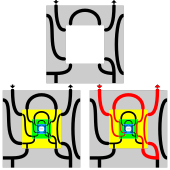
In Greek mythology, the Labyrinth was an elaborate, confusing structure designed and built by the legendary artificer Daedalus for King Minos of Crete at the Knossos. Its function was to hold the Minotaur, the monster eventually killed by the hero Theseus. Daedalus had so cunningly made the Labyrinth that he could barely escape it after he built it.

Topiary is the horticultural practice of training perennial plants by clipping the foliage and twigs of trees, shrubs and subshrubs to develop and maintain clearly defined shapes, whether geometric or fanciful. The term also refers to plants which have been shaped in this way. As an art form it is a type of living sculpture. The word derives from the Latin word for an ornamental landscape gardener, topiarius, a creator of topia or "places", a Greek word that Romans also applied to fictive indoor landscapes executed in fresco.

Hampton Court Maze is a hedge maze at Hampton Court Palace and the oldest surviving hedge maze in Britain.

Longleat is a stately home about 4 miles (7 km) west of Warminster in Wiltshire, England. A leading and early example of the Elizabethan prodigy house, it is a Grade I listed building and the seat of the Marquesses of Bath.

A caerdroia is a Welsh turf maze, usually in the sevenfold Cretan labyrinth design. They were created by shepherds on hilltops and were apparently the setting for ritual dances, the nature of which has been lost. At the centre of each caerdroia was a small hillock—in Welsh, twmpath. A gathering for folk dancing in Wales is still called a twmpath dawns. It is a typical labyrinth of Welsh but there is a specimen in Italy to Petrella Tifernina discovered by the historian Mario Ziccardi. This specimen is the only one in the Mediterranean area for now.
Adrian Fisher is a British pioneer, inventor, designer and creator of mazes, puzzles, public art, tessellations, tilings, patterns and networks of many kinds. He is responsible for more than 700 mazes in 42 countries since 1979.

Historically, a turf maze is a labyrinth made by cutting a convoluted path into a level area of short grass, turf or lawn. Some had names such as Mizmaze, Troy Town, The Walls of Troy, Julian's Bower, or Shepherd's Race. This is the type of maze referred to by William Shakespeare in A Midsummer Night's Dream when Titania says:

Mizmaze is the name given to two of England's eight surviving historic turf mazes, and also to a third, presumably once similar site that is now merely a relic. Of the two which survive, one is at Breamore, in Hampshire; the other is on top of St Catherine's Hill, overlooking the city of Winchester, Hampshire.

A picture maze is a maze puzzle designed to resemble something visually, or one where the solution traces out a particular picture.
Gilbert Randoll Coate was a British diplomat, maze designer and "labyrinthologist".

A hedge maze is an outdoor garden maze or labyrinth in which the "walls" or dividers between passages are made of vertical hedges.

A corn maze or maize maze is a maze cut out of a corn field. Corn mazes have become popular agritourism attractions in North America, and are a way for farms to generate tourist income. Corn mazes appear in many different designs. Most have a path which goes all around the whole pattern, either to end in the middle or to come back out again, with various false trails diverging from the main path. In the United Kingdom, they are known as maize mazes, and are especially popular with farms in the east of England.

Uncle Henry's Playhouse is the third game in The 7th Guest series. Functionally the game is a compilation game mostly composed of the puzzles from Trilobyte's games The 7th Guest, The 11th Hour, and Clandestiny, but featuring little plot. The game has been noted for its low sales figures and its rarity/obscurity relative to its blockbuster predecessors, The 7th Guest and The 11th Hour. The game is primarily intended as a means of presenting puzzles from the previous titles in the 7th Guest series and consequently it has a rather simplistic plot that has been criticized by reviewers for its thinness in comparison to the previous games. The game also includes previews for two then-upcoming Trilobyte games, Tender Loving Care and Dog Eat Dog.

Finca Los Alamos is a historic Argentine estancia located in San Rafael, Mendoza. The estate was built in 1830 by the Bombal family, and originally served as a frontier fort. Domingo Bombal, who served eleven terms as Governor to the Mendoza Province, owned the estate until his death in 1908.

A maze-solving algorithm is an automated method for solving a maze. The random mouse, wall follower, Pledge, and Trémaux's algorithms are designed to be used inside the maze by a traveler with no prior knowledge of the maze, whereas the dead-end filling and shortest path algorithms are designed to be used by a person or computer program that can see the whole maze at once.
Dave Phillips is a maze and puzzle designer, and writer of The Zen Of The Labyrinth—Mazes For The Connoisseur. Phillips has provided puzzles for Reader's Digest, Highlights, National Geographic World, Die Zeit, Ranger Rick, Omni, Games, Scientific American, and United Features Syndicate. He has also created jigsaw puzzle mazes for Hallmark and die cut puzzle mazes for DaMert.

Adventure Wonderland was a family theme park situated in the village of Hurn, near Bournemouth, United Kingdom. The park offered rides and attractions aimed at families with children up to the age of 10. It drew much of its theme from the novel Alice in Wonderland by Lewis Carroll and Alice, The Mad Hatter, the Queen of Hearts, The Cheshire Cat, and The White Rabbit make appearances throughout the day around the park and in the theatre shows.

The labyrinth of Versailles was a hedge maze in the Gardens of Versailles with groups of fountains and sculptures depicting Aesop's Fables. André Le Nôtre initially planned a maze of unadorned paths in 1665, but in 1669, Charles Perrault advised Louis XIV to include thirty-nine fountains, each representing one of the fables of Aesop. The work was carried out between 1672 and 1677. Water jets spurting from the animals mouths were conceived to give the impression of speech between the creatures. There was a plaque with a caption and a quatrain written by the poet Isaac de Benserade next to each fountain. A detailed description of the labyrinth, its fables and sculptures is given in Perrault's Labyrinte de Versailles, illustrated with engravings by Sébastien Leclerc.

Bridge End Gardens is a group of linked ornamental gardens in Saffron Walden, Essex, England. The gardens are listed Grade II* on the Register of Parks and Gardens. They are located off Castle Street, close to the Fry Art Gallery. Features include a maze.

A formal garden is a garden with a clear structure, geometric shapes and in most cases a symmetrical layout. Its origin goes back to the gardens which are located in the desert areas of Western Asia and are protected by walls. The style of a formal garden is reflected in the Persian gardens of Iran, and the monastic gardens from the Late Middle Ages. It has found its continuation in the Italian Renaissance gardens and has culminated in the French formal gardens from the Baroque period. Through its design, the garden conveys a sense of established order and transparency to the observer.





























